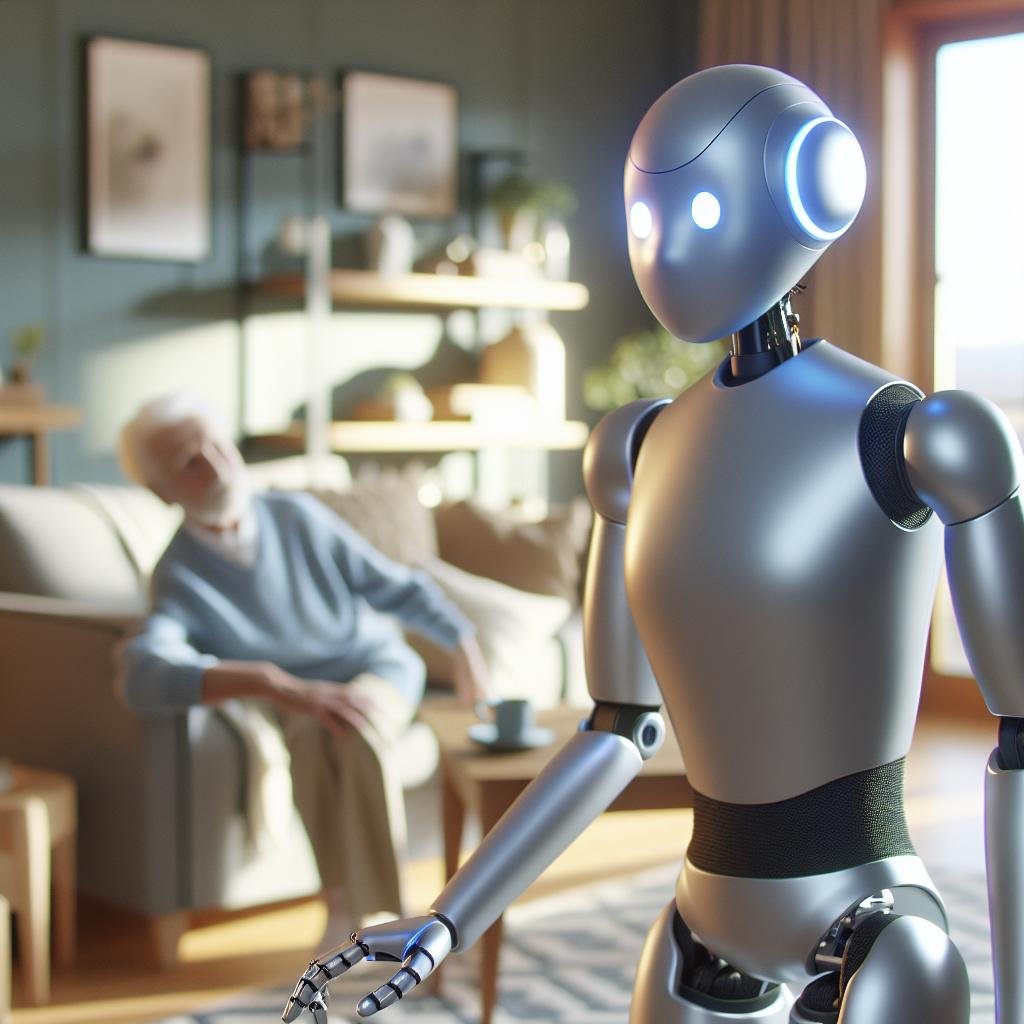
Amazon Robot with Touch: Essential Innovation Guide
Amazon has unveiled “Vulcan,” a groundbreaking robot capable of sensing touch, marking a major advance in robotics technology. This new robot, developed by Amazon’s AI research lab in Seattle, combines artificial intelligence with sophisticated tactile sensors that allow it to handle objects with unprecedented dexterity. Unlike conventional robots that rely primarily on visual data, Vulcan can “feel” what it touches, enabling it to perform complex manipulations that were previously impossible for machines.
How Vulcan’s Touch Sensing Technology Works
Vulcan represents a significant leap forward in robotic touch capabilities. The robot uses specialized GelSight sensors mounted on its fingertips, which contain cameras that capture microscopic deformations when the robot touches an object. This technology allows Vulcan to detect forces as subtle as 0.1 Newtons—equivalent to the weight of about 10 paper clips.
The robot’s sensory system creates detailed force maps when contacting surfaces, providing rich tactile feedback similar to what humans experience when touching objects. This data feeds into Vulcan’s neural networks, helping it understand how to interact with different materials and shapes.
Pete Florence, a robotics scientist who co-leads the project, explains that this tactile ability addresses a fundamental limitation in robotics: “Vision alone can’t tell you how to manipulate something. Touch gives you information about forces and friction that vision simply cannot provide.”
The AI Behind Amazon’s Sensitive Robot
Vulcan’s abilities extend beyond hardware innovations. The robot employs sophisticated machine learning models that process and interpret tactile data in real-time. These AI systems allow Vulcan to learn from experience, adapting its approach based on how objects feel and respond to manipulation.
Amazon’s research team trained Vulcan using a technique called reinforcement learning, where the robot receives positive feedback when it successfully completes tasks. Through thousands of trial-and-error attempts, Vulcan learned to:
- Apply appropriate pressure when handling delicate items
- Detect when objects slip during grasping
- Adjust its grip based on an object’s weight and texture
- Manipulate flexible materials like fabrics and cables
This combination of tactile sensors and AI creates what researchers call “closed-loop tactile control”—a continuous feedback process where touch information guides the robot’s movements just as it does for humans.
Challenges in Developing Touch-Sensitive Robots
Creating robots with effective touch capabilities presents unique challenges compared to other sensory systems. Unlike vision systems that can use standard camera technology, tactile sensing requires specialized hardware that can withstand physical contact while remaining sensitive enough to detect subtle pressure changes.
According to Dr. Georgia Chalvatzaki, a robotics expert at TU Darmstadt who was not involved in Amazon’s project, “Touch sensing is particularly difficult because it requires direct contact with the environment, which introduces wear-and-tear issues that vision systems don’t face.” This physical interaction increases the risk of sensor damage and requires durable designs that don’t compromise sensitivity.
Another significant challenge involves interpreting tactile data. While visual information follows relatively standardized patterns, touch data varies widely depending on the sensor technology, surface properties, and contact dynamics. Creating algorithms that can make sense of this complex information has been a major focus of Amazon’s research team.
Potential Applications in Amazon’s Operations
Amazon has not explicitly stated how Vulcan might be deployed in its operations, but the potential applications are extensive. In warehouse environments, touch-sensitive robots could transform how items are picked, packed, and handled.
The most immediate applications might include:
- Precise handling of fragile items that current robots struggle with
- Sorting mixed products of different sizes, weights, and materials
- Manipulating flexible packaging materials like bags and envelopes
- Detecting product defects through touch that cameras might miss
Dieter Fox, who leads Amazon’s Seattle AI lab, suggests that these capabilities could eventually extend beyond warehouses: “The ability to manipulate objects through touch opens possibilities in last-mile delivery, household assistance, and even manufacturing.”
Real-World Example
Imagine a Vulcan robot working alongside human employees in an Amazon fulfillment center. While traditional robots handle standardized boxes and rigid items, Vulcan tackles the trickier tasks. When a customer orders a delicate glass ornament packaged in a soft pouch, Vulcan gently squeezes the package—just enough to secure it without causing damage. It detects the fragile object inside through its tactile sensors and adjusts its grip pressure accordingly. When the ornament shifts slightly during transport, Vulcan feels the weight redistribution and automatically rebalances its hold—something conventional robots would miss entirely, potentially resulting in a dropped package and a disappointed customer.
As one Amazon engineer joked during a demonstration: “It’s like the difference between trying to make a sandwich while wearing thick winter gloves versus using your bare hands. Vulcan finally lets our robots take off those metaphorical gloves.”
The Broader Impact on Robotics and Automation
Vulcan’s development signals a significant shift in robotics research priorities. For decades, vision has dominated robot perception systems, with cameras becoming increasingly sophisticated and processing algorithms more advanced. Touch, by comparison, has remained underdeveloped despite its crucial role in human manipulation skills.
Ken Goldberg, robotics professor at UC Berkeley, notes that Amazon’s investment in tactile robotics could accelerate progress across the field: “When major companies like Amazon make significant investments in touch-sensing technology, it creates momentum that benefits the entire research community.”
This momentum extends beyond hardware to include simulation tools, datasets, and standardized testing methods for tactile capabilities—all essential components for advancing robot manipulation skills.
Comparing Vulcan to Other Touch-Sensitive Robots
While Vulcan represents a major advance, it builds upon earlier research in tactile robotics. Other notable projects include:
- MIT’s SACX system, which uses similar GelSight technology but with different learning approaches
- SynTouch’s BioTac sensors, which mimic human fingertips using fluid-filled elastomer membranes
- The RoboSkin project from the European Commission, which developed large-area touch sensors for humanoid robots
What distinguishes Vulcan is the integration scale and the sophisticated AI systems that interpret tactile data. Rather than using touch for simple contact detection, Vulcan leverages tactile information for complex manipulation strategies that adapt to different objects and conditions.
The system also appears more robust than previous research prototypes, suggesting Amazon has addressed some of the durability challenges that have limited tactile sensing in commercial applications.
Addressing Concerns About Automation and Jobs
Advanced robots like Vulcan inevitably raise questions about workforce impacts and automation. Amazon has consistently maintained that its robotics research aims to complement human workers rather than replace them.
The company points to its employment growth alongside its increasing robot deployment as evidence of this complementary relationship. Since introducing its first warehouse robots in 2012, Amazon has added over 300,000 warehouse jobs globally.
Research supports the idea that tactile robots may be better suited to collaboration than replacement. A McKinsey Global Institute report suggests that jobs requiring dexterity and tactile judgment remain among the least automatable, with robots more likely to take over repetitive tasks while humans handle complex manipulations.
However, as tactile capabilities improve, this division of labor could shift. Amazon’s researchers acknowledge this possibility while emphasizing the long timeline for deployment beyond research settings.
The Future Development Path for Tactile Robotics
Vulcan represents an important milestone, but significant challenges remain before touch-sensitive robots become commonplace. Future research directions will likely include:
- Miniaturization of tactile sensors to allow more coverage across robot surfaces
- Development of self-healing or replaceable sensor materials to address wear issues
- Creation of standardized tactile datasets to accelerate machine learning approaches
- Integration of tactile information with other sensory modalities like vision and sound
Amazon’s Fox indicates that the team is already working on next-generation sensors with improved durability and sensitivity: “The current sensors give us tremendous capabilities, but we’re just at the beginning of what’s possible with tactile robotics.”
The company has also hinted at exploring biomimetic approaches that more closely replicate human touch receptors, potentially including temperature sensing and detection of surface textures at a microscopic level.
Ethical Considerations in Advanced Robotics
As robots gain more human-like capabilities, including touch, they raise new ethical questions about autonomy, decision-making, and human-robot interactions. Amazon has established internal ethics guidelines for its robotics research, including principles for safe operation, transparent capabilities, and appropriate deployment contexts.
These guidelines address concerns about robots making decisions based on tactile information—for example, determining whether an object is too fragile to handle or requires special care. The company emphasizes human oversight of these systems, particularly during their development stages.
The broader robotics community has similarly called for thoughtful approaches to increasingly capable robots. The IEEE Global Initiative on Ethics of Autonomous and Intelligent Systems provides frameworks that companies like Amazon can reference as they develop systems like Vulcan.
What’s Next for Amazon’s Robotics Program
While Vulcan currently exists as a research platform, Amazon’s history suggests a path toward practical applications. The company typically develops technologies in research settings before adapting promising approaches for operational use.
Amazon executives have indicated that tactile capabilities will likely appear first in controlled environments like sorting centers before expanding to more complex scenarios. This gradual deployment allows for refinement of both the technology and the human-robot workflows that incorporate it.
Beyond warehouse applications, Amazon has expressed interest in how tactile robotics might enhance other product lines, including consumer devices and delivery systems. While speculative, these possibilities indicate the company sees touch as a foundational capability for next-generation robotics.
Conclusion: The Significance of Robot Touch
Vulcan represents more than just another advance in Amazon’s robotics program—it signals a fundamental shift in how machines interact with the physical world. By enabling robots to feel what they touch, Amazon has addressed one of the most significant limitations in current automation systems.
This capability bridges the gap between human and robotic manipulation, opening possibilities for more sophisticated collaboration between people and machines. While practical applications may take time to develop, the foundation established by Vulcan points toward robots that can work more safely, effectively, and intelligently alongside humans.
As tactile sensing continues to advance, we may soon see robots handling tasks that previously required human touch—from packaging delicate items to assisting with complex assembly operations. Amazon’s investment in this technology positions the company at the forefront of this evolving field.
Have thoughts about touch-sensitive robots or questions about how this technology might impact different industries? Share your perspectives in the comments section below!
References
- AI Lab Amazon Launches Vulcan, a Robot That Can Feel – WIRED
- Jobs Lost, Jobs Gained: Workforce Transitions in a Time of Automation – McKinsey Global Institute
- IEEE Global Initiative on Ethics of Autonomous and Intelligent Systems
- Tactile Sensing for Dexterous In-Hand Manipulation in Robotics – Columbia University
- Tactile Sensing and Control of Robotic Manipulation – Science Robotics Journal


